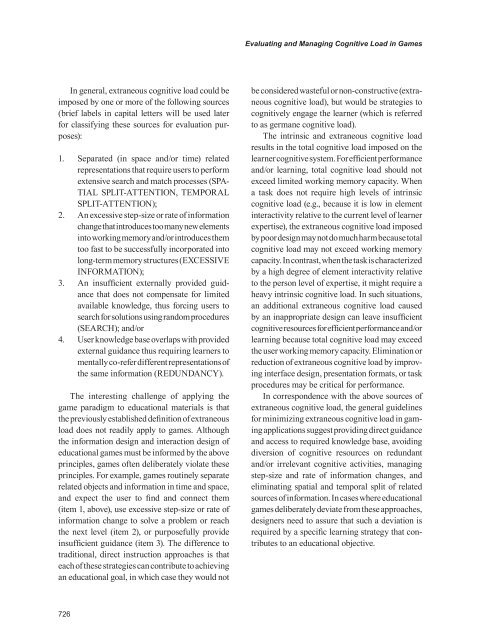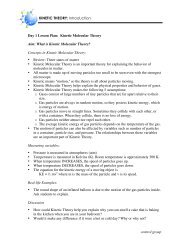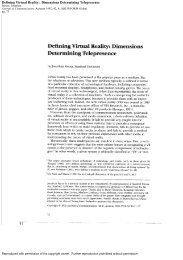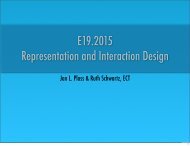Evaluating and managing cognitive load in educational games
Evaluating and managing cognitive load in educational games
Evaluating and managing cognitive load in educational games
You also want an ePaper? Increase the reach of your titles
YUMPU automatically turns print PDFs into web optimized ePapers that Google loves.
<strong>Evaluat<strong>in</strong>g</strong> <strong>and</strong> Manag<strong>in</strong>g Cognitive Load <strong>in</strong> Games<br />
In general, extraneous <strong>cognitive</strong> <strong>load</strong> could be<br />
imposed by one or more of the follow<strong>in</strong>g sources<br />
(brief labels <strong>in</strong> capital letters will be used later<br />
for classify<strong>in</strong>g these sources for evaluation purposes):<br />
1. Separated (<strong>in</strong> space <strong>and</strong>/or time) related<br />
representations that require users to perform<br />
extensive search <strong>and</strong> match processes (SPA-<br />
TIAL SPLIT-ATTENTION, TEMPORAL<br />
SPLIT-ATTENTION);<br />
2. An excessive step-size or rate of <strong>in</strong>formation<br />
change that <strong>in</strong>troduces too many new elements<br />
<strong>in</strong>to work<strong>in</strong>g memory <strong>and</strong>/or <strong>in</strong>troduces them<br />
too fast to be successfully <strong>in</strong>corporated <strong>in</strong>to<br />
long-term memory structures (EXCESSIVE<br />
INFORMATION);<br />
3. An <strong>in</strong>sufficient externally provided guidance<br />
that does not compensate for limited<br />
available knowledge, thus forc<strong>in</strong>g users to<br />
search for solutions us<strong>in</strong>g r<strong>and</strong>om procedures<br />
(SEARCH); <strong>and</strong>/or<br />
4. User knowledge base overlaps with provided<br />
external guidance thus requir<strong>in</strong>g learners to<br />
mentally co-refer different representations of<br />
the same <strong>in</strong>formation (REDUNDANCY).<br />
The <strong>in</strong>terest<strong>in</strong>g challenge of apply<strong>in</strong>g the<br />
game paradigm to <strong>educational</strong> materials is that<br />
the previously established def<strong>in</strong>ition of extraneous<br />
<strong>load</strong> does not readily apply to <strong>games</strong>. Although<br />
the <strong>in</strong>formation design <strong>and</strong> <strong>in</strong>teraction design of<br />
<strong>educational</strong> <strong>games</strong> must be <strong>in</strong>formed by the above<br />
pr<strong>in</strong>ciples, <strong>games</strong> often deliberately violate these<br />
pr<strong>in</strong>ciples. For example, <strong>games</strong> rout<strong>in</strong>ely separate<br />
related objects <strong>and</strong> <strong>in</strong>formation <strong>in</strong> time <strong>and</strong> space,<br />
<strong>and</strong> expect the user to f<strong>in</strong>d <strong>and</strong> connect them<br />
(item 1, above), use excessive step-size or rate of<br />
<strong>in</strong>formation change to solve a problem or reach<br />
the next level (item 2), or purposefully provide<br />
<strong>in</strong>sufficient guidance (item 3). The difference to<br />
traditional, direct <strong>in</strong>struction approaches is that<br />
each of these strategies can contribute to achiev<strong>in</strong>g<br />
an <strong>educational</strong> goal, <strong>in</strong> which case they would not<br />
be considered wasteful or non-constructive (extraneous<br />
<strong>cognitive</strong> <strong>load</strong>), but would be strategies to<br />
<strong>cognitive</strong>ly engage the learner (which is referred<br />
to as germane <strong>cognitive</strong> <strong>load</strong>).<br />
The <strong>in</strong>tr<strong>in</strong>sic <strong>and</strong> extraneous <strong>cognitive</strong> <strong>load</strong><br />
results <strong>in</strong> the total <strong>cognitive</strong> <strong>load</strong> imposed on the<br />
learner <strong>cognitive</strong> system. For efficient performance<br />
<strong>and</strong>/or learn<strong>in</strong>g, total <strong>cognitive</strong> <strong>load</strong> should not<br />
exceed limited work<strong>in</strong>g memory capacity. When<br />
a task does not require high levels of <strong>in</strong>tr<strong>in</strong>sic<br />
<strong>cognitive</strong> <strong>load</strong> (e.g., because it is low <strong>in</strong> element<br />
<strong>in</strong>teractivity relative to the current level of learner<br />
expertise), the extraneous <strong>cognitive</strong> <strong>load</strong> imposed<br />
by poor design may not do much harm because total<br />
<strong>cognitive</strong> <strong>load</strong> may not exceed work<strong>in</strong>g memory<br />
capacity. In contrast, when the task is characterized<br />
by a high degree of element <strong>in</strong>teractivity relative<br />
to the person level of expertise, it might require a<br />
heavy <strong>in</strong>tr<strong>in</strong>sic <strong>cognitive</strong> <strong>load</strong>. In such situations,<br />
an additional extraneous <strong>cognitive</strong> <strong>load</strong> caused<br />
by an <strong>in</strong>appropriate design can leave <strong>in</strong>sufficient<br />
<strong>cognitive</strong> resources for efficient performance <strong>and</strong>/or<br />
learn<strong>in</strong>g because total <strong>cognitive</strong> <strong>load</strong> may exceed<br />
the user work<strong>in</strong>g memory capacity. Elim<strong>in</strong>ation or<br />
reduction of extraneous <strong>cognitive</strong> <strong>load</strong> by improv<strong>in</strong>g<br />
<strong>in</strong>terface design, presentation formats, or task<br />
procedures may be critical for performance.<br />
In correspondence with the above sources of<br />
extraneous <strong>cognitive</strong> <strong>load</strong>, the general guidel<strong>in</strong>es<br />
for m<strong>in</strong>imiz<strong>in</strong>g extraneous <strong>cognitive</strong> <strong>load</strong> <strong>in</strong> gam<strong>in</strong>g<br />
applications suggest provid<strong>in</strong>g direct guidance<br />
<strong>and</strong> access to required knowledge base, avoid<strong>in</strong>g<br />
diversion of <strong>cognitive</strong> resources on redundant<br />
<strong>and</strong>/or irrelevant <strong>cognitive</strong> activities, <strong>manag<strong>in</strong>g</strong><br />
step-size <strong>and</strong> rate of <strong>in</strong>formation changes, <strong>and</strong><br />
elim<strong>in</strong>at<strong>in</strong>g spatial <strong>and</strong> temporal split of related<br />
sources of <strong>in</strong>formation. In cases where <strong>educational</strong><br />
<strong>games</strong> deliberately deviate from these approaches,<br />
designers need to assure that such a deviation is<br />
required by a specific learn<strong>in</strong>g strategy that contributes<br />
to an <strong>educational</strong> objective.<br />
726








